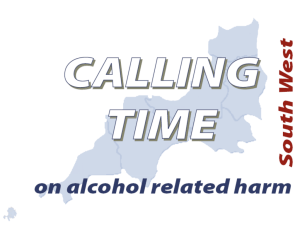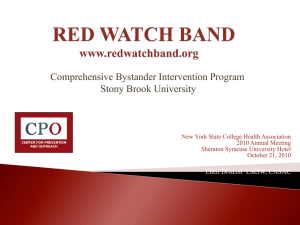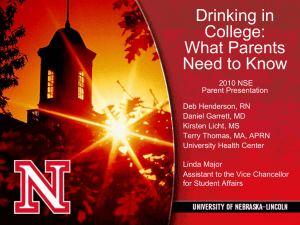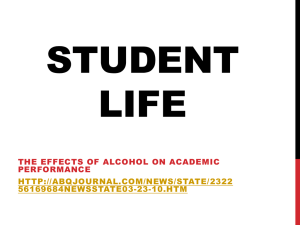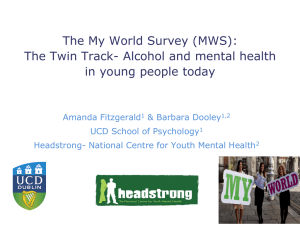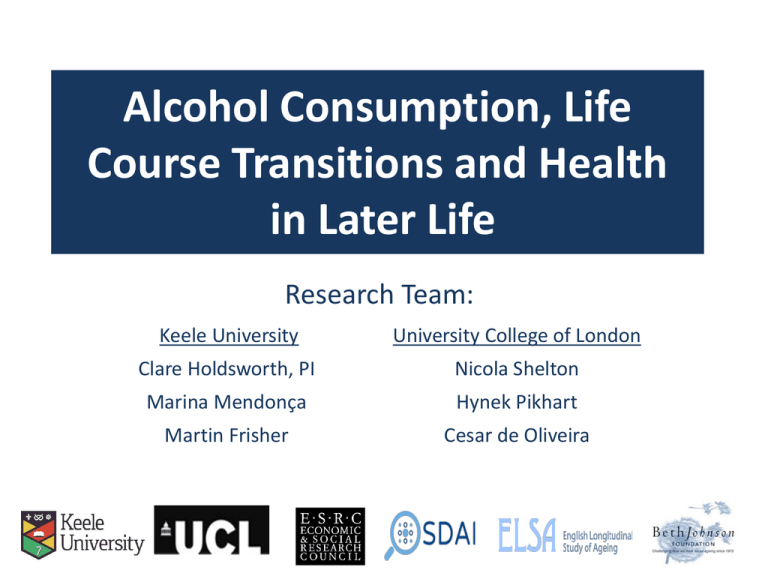
Alcohol Consumption, Life
Course Transitions and Health
in Later Life
Research Team:
Keele University
University College of London
Clare Holdsworth, PI
Nicola Shelton
Marina Mendonça
Hynek Pikhart
Martin Frisher
Cesar de Oliveira
Presentation
• Introduction to the project
• Data and methodology
• Findings:
– Cross-sectional analysis of drinking profiles and
health
– Longitudinal analysis of drinking quantity and
frequency over time
• Policy implications
Research Objectives
• To extend understanding of the diversity of patterns of alcohol
consumption at older ages;
• To identify the socio-demographic dynamics of drinking during later life
and the life events that are associated with changes in drinking
behaviours;
• To explore the relationship between drinking and health conditions in
later life;
• To establish the importance of secondary survey data in supporting policy
initiatives directed towards individual health behaviours;
• To inform health policy initiatives on drinking in later life through
identifying the risks associated with excessive drinking (binge drinking or
drinking more than recommended weekly amounts) and the relationship
between alcohol consumption, health and well-being in later life.
Data & Methodology
• English Longitudinal Study of Ageing (ELSA):
ELSA W0 (HSE): Baseline for
alcohol variables
1998 1999
2001
W1
2002/3
W2
W3
W4
2004/5 2006/7 2008/9
W5
W6
2010/11 2012/13
• Practice-informed modeling approach in collaboration with Beth
Johnson Foundation
• Cross-sectional analysis: Association between alcohol consumption
and socio-demographic and health variables
• Longitudinal analysis: Sequencing drinking behaviours over life
course; link between drinking behaviours and health; identifying
whether changes in drinking behaviours are associated with
individual characteristics
Table 1: Percentage distribution of drinking
profiles by gender, wave 0 .
Drinking Variables
Drinking
Status
Quantity of
Alcohol
% Respondents wave 0
Frequency of
drinking
Non-drinker
Drinker
Drinking Profiles
Men
Women
Non-Drinker
7
14
Below
Recommended
Limits
(Men ≤21 units;
Women≤ 14
units)
Occasional
(≤ 4 days)
Low Risk:
Occasional Drinker
54
64
Daily
(≥ 5days)
Low Risk:
Daily Drinker
12
8
Above
Recommended
Limits
(Men > 21 units
Women > 14
unit)
Occasional
(≤ 4 days)
Focal Drinker
7
3
Daily
(≥ 5days)
Heavy Drinker
20
11
Number of cases = 11205
Figure 1: Percentage Distribution of Drinking
profiles by age and gender: wave 0
Non-drinker
Low Risk:Occas.
Low risk: Daily
Focal
Heavy
80
70
60
50
40
30
20
10
0
Men 45-64
Women 4564
Number of cases = 11205
Men 65-74
Women 6574
Men 75+
Women 75 +
Figure 2: Percentage of drinking profiles with
poor self-rated: wave 0 and wave 5
Wave 0
20
18
16
14
12
10
8
6
4
2
0
Wave 5
Non-drinker: Non-drinker:
Always
Stopped
drinking
Number of cases = 5868
Low Risk
Steady
Focal
Heavy
Figure 3a and b: Unadjusted and adjusted odds
ratios predicting poor self rated health:
Odds ratios Log scale
Reference: Occasional Drinker Unadjusted odd ratios
10
1
0.1
Low risk:
weekly
Low risk: daily
Focal:
Hazardous
Focal: High
Risk
Heavy:
Hazardous
Heavy: High
Risk
Heavy:
Hazardous
Heavy: High
Risk
Odds ratios: Log scale
Reference: Occasional Drinker Adjusted odds ratios
10
1
0.1
Low risk:
weekly
Low risk: daily
Focal:
Hazardous
Focal: High Risk
Adjusted for: Age, gender, wealth, social class, education, household size, smoking, BMI
Longitudinal Analysis
• Multilevel level longitudinal analysis using alcohol
variables in waves 0, 4 and 5
• Quantity:
– Growth curve model of log of weekly units of alcohol
consumed
– Restricted to drinkers at all 3 time points (3610 valid cases)
• Frequency
– Ordered logistic regression using frequency of drinking in
last 12 months
– Restricted to respondents at all 3 time points (4740 valid
cases)
123456789
1011121314151617181920
Figure 4: Average weekly units over time
by gender
0
4
wave
sex=male
sex=female
5
Table 2: Average weekly units consumed for synthetic profiles
of older people
Pauline:
Pearl:
Doreen:
Dorothy:
In partnership,
Retired, Good
health,
Some qualifications,
Non-smoker,
Average Wealth
Not in partnership,
Retired,
Not in good health,
No qualifications,
Non-smoker,
Lowest wealth group
In partnership, Working,
Good health,
University degree ,
Former smoker,
Highest wealth group
During 10 year period:
• Loses partner, retires
& health deteriorates
A level qualifications
Non-smoker, Above
average wealth
Age 60
Age 70
Age 80
Age 90
Age 50
Age 60
Age 60
Age 70
3.95
3.50 (11%)
3.43
2.92 (15%)
11.92
10.18 (15%)
5.84
4.54(22%)
Paul:
Peter:
Duncan:
Derek:
In partnership,
Retired, Good
health, Some
qualifications, Nonsmoker, Average
Wealth
Not in partnership,
Retired
Not in good health
No qualifications
Non-smoker
Lowest wealth group
During 10 year period:
• Gets married
Working, Good health,
University degree,
Former smoker,
Highest wealth group
During 10 year period:
• Loses partner, retires
& health deteriorates
A level qualifications
Non-smoker
Above average wealth
Age 65
Age 75
Age 80
Age 90
Age 50
Age 60
Age 60
Age 70
6.75
5.76 (15%)
7.47
6.04 (19%)
33.80
28.0 (17%)
7.76
6.81 (12%)
Figure 5: Percentage distribution of
drinking frequency waves 0 and 5
Wave 0
30
25
20
15
10
5
0
Wave 5
Did not Drinks Drinks
drink in Once or once
last year twice a every
year couple of
months
Number of cases = 4780
Drinks Drinks
once or one to
twice a two days
month a week
Drinks Drinks Drinks
three to five to six almost
four days days a every day
a week
week
Table 3: Summary of results of longitudinal
model of frequency of drinking - 1
Variable
Time (continuous variable)
Partnership status
Reference: Always in partnership
•
Always out of partnership
•
Enters into partnership between waves
•
Partnerships ends between waves
Employment status
Reference: Always in work
•
Always retired
•
Transition to retirement between waves
Health:
Reference always in good health
•
Always in poor health
•
Health worsens between waves
•
Health improves between waves
Men
-0.11
Women
-0.16
0.28
0.56
0.03
-0.07
0.47
-0.08
0.28
-0.08
0.55
0.13
-0.61
-0.25
-0.77
-1.21
-0.12
-0.76
Table 3: Summary of results of longitudinal
model of frequency of drinking - 2
Men
Wealth Quintile
Reference category: Bottom Quintile
•
2nd Quintile
•
3rd Quintile
•
4th Quintile
•
5th Quintile
Education:
Reference: No qualifications
•
Some qualifications
•
A-level or equivalent
•
Degree
Women
0.48
0.63
0.75
1.41
0.52
0.80
1.42
1.97
0.28
0.39
1.41
0.59
0.80
1.16
Table 3: Summary of results of longitudinal
model of frequency of drinking - 3
Variable
Partnership status * Time
Reference: Always in partnership
•
Always out of partnership
•
Enters into partnership between waves
•
Partnerships ends between waves
Health: * Time
Reference always in good health
•
Always in poor health
•
Health worsens between waves
•
Health improves between waves
Men
Women
-0.10
-0.01
-0.02
-0.09
-0.07
-0.07
-0.14
-0.09
-0.06
-0.12
-0.13
-0.02
Main Findings: Drinking, socio-economic status
and partnership
• Older men tend to drink more and to drink more often than
women.
• Men and women in higher income groups and with higher
levels of education drink more and drink more frequently.
• Both the amount that older people drink and how often they
drink declines over time.
• Men who are not in a partnership drink more compared to
men with a partner, though there is no difference in the
frequency of men’s drinking by partnership status.
• For women loss of a partner is associated with a faster decline
in weekly alcohol consumption and with drinking less often.
Main Findings: Drinking in later life and
health
• Poorer self-rated health is associated with not drinking.
• Among drinkers, there is no evidence that a moderate amount
of alcohol consumption improves health in later life compared
to heavy drinking.
• Over time older people with poor self-rated health and
deteriorating health report a steeper decline in the quantity
and frequency of alcohol consumed (similar finding for
depression).
• Those who stopped drinking at the start of the period of
observation and remained in the study were more likely to
experience an improvement in health compared to drinkers.
Policy Implications
•
•
•
•
•
Rethink causality between health and drinking in later life?
Older people moderate their drinking if their health declines.
But the message that moderate drinking is good for you is not supported by this
analysis. Furthermore for this sample we did not find that excessive drinking
causes a deterioration of health in later life.
Those who stopped drinking were more likely to experience an improvement in
health compared to drinkers so cessation may be recommended for older people
in poor health.
Those at most risk of drinking in excess and drinking most frequently are well
educated and have high wealth. This is a concern particularly as the prosperity of
older people improves then this may lead to more people drinking excessively in
later life. This group of successful older people could be resistant to public health
messages.
•“The
Partnership
makes
a difference
much
people
drinkin
though
differs
public health
message
shouldto
behow
make
sureolder
you’ve
got things
place,this
go and
forfriends,
men and
women.
The you
social
of drinking
is important
andit advice
about
make
you
know, get
lifecontext
organised
so that you’re
enjoying
because
I
drinking
needs to be asensitive
to partnership
status.
think
again anecdotally
lot of men
don’t maintain
contact with people”

